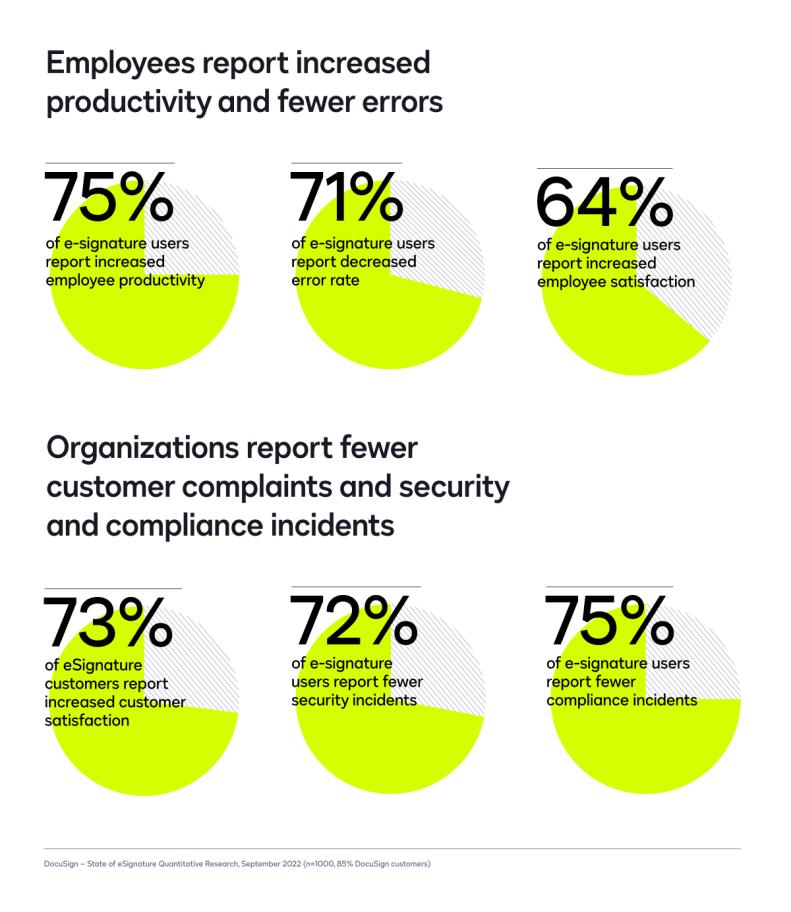Building a Business Case for Electronic Signature
Teams looking to make significant new technology investments are facing serious friction. There’s a lot of general economic uncertainty and it has led to a series of new obstacles for anyone looking to justify a new purchase. Even with popular business tools, the increased scrutiny on new purchases requires leaders to build a solid business case and answer a series of tough questions to justify a new investment.
A strong case will include research to detail the costs and benefits of a new purchase. It should also include other important effects you expect to see. You need to prove that you’ve thought through the purchase from beginning to end. It’s hard to make a business case with broad generalities. You need metrics. For example, it’s good to know that Docusign eSignature customers overwhelmingly agree that they are completing agreements faster and cheaper. But to be the most convincing, you need to know exactly how much time and how much money they are saving.
If your organization hasn’t started using an e-signature solution, it’s time to build a strong business case for adoption. To help you do just that, Docusign conducted in-depth quantitative research about the way e-signature impacts an organization. Our goal was to build a checklist of common questions and answer them with real numbers that can help set expectations for anyone considering an investment in e-signature.
This blog will share a few of the data points you need to build a strong case for e-signature. To see the complete results (and all the supporting data), download the How to Measure the Value of E-Signature whitepaper.
The business case for electronic signatures
Docusign eSignature customers report:
-
Time savings: Time spent collecting signatures is reduced by an average of 25-50% and contract turnaround time improves by 75%
-
Hard cost savings: Cost of paper, ink, postage and couriers is cut by an average of $4-10 per document, but there's potential for even more
How much time does Docusign eSignature save?
The average eSignature customer reduces time spent on signature collection work by about a third. That number is a summary of past performance, not a guarantee of future results, but it’s a reliable number to guide your expectations about the impact of the technology.
Around four in five Docusign agreements are signed within 24 hours; 44% are signed within 15 minutes. Turnaround time like that is a simple way to accelerate ongoing contracting work and free up employee time to work on new projects. If you’re making a business case to your boss, make suggestions about what employees could do with the extra time and what impact that would have on revenue.
eSignature offers the potential to eliminate some hard costs
Moving signature activity to a digital platform significantly reduces the costs of printing, shipping and storing documents. While Docusign eSignature customers save an average of $4-10 per document, there’s potential to entirely eliminate those expenses with a commitment to electronic signature.
If your team is looking to estimate the hard cost savings to expect by updating your signature processes, all you need is an estimate of how many documents are completed in a specific period. If you don’t already track that information, it’s definitely time to start.
Better signatures open the door for new revenue
Docusign eSignature customers are doing more than just cutting costs, they’re using their improved signature capabilities to sell better and close deals faster. With an improved agreement process, it’s easier than ever for interested customers to complete a deal. If a purchase involves two close competitors, the decision might come down to which one can get an offer on the table first. Docusign customers see the results of streamlined sales contracts: teams using eSignature report an 8% increase in win rate and a 41% decrease in time to close deals.
Electronic signature improve critical KPIs across every team
There’s more to e-signature adoption than just time and money savings. While those measures are probably the most direct way to translate process improvements into revenue, e-signature touches every part of an organization and impacts a wide range of metrics. Some of those are directly tied to revenue. Others impact revenue indirectly (e.g. customer satisfaction) or achieve another important organizational goal (e.g. paper reduction).
To make a strong business case, talk to other leaders around your organization and find out which parts of their workflow are impacted by the signature process. It’s likely that you’ll find some critical company KPIs that can be improved with e-signature technology. Here’s a sample of the common benefits reported by teams using electronic signature technology:

Looking at the overall picture, it’s clear that e-signature makes business run smoother and improves relationships with multiple key stakeholders. It’s a transformation that moves the entire organization forward into the modern economy.
Are you looking for more data to help you make your case to adopt eSignature? Our free How to Measure the Value of E-Signature whitepaper has all the information you need.